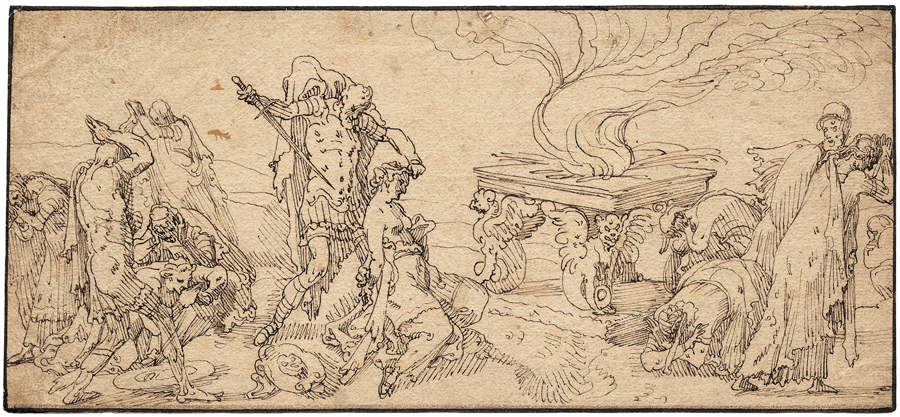Loading the page ...
Pieter Aertsen
(1508–1575, Amsterdam)
The Sacrifice of Iphigenia. Pen and brown ink, borderline in red chalk, reworked in black ink. 11.8 x 25.9 cm.
The first basic monographic essay on the drawings of Pieter Aertsen was written in 1965 by J. Bruyn (“Some Drawings by Pieter Aertsen,” in Master Drawings, III, 4, 1965, pp 355–368). In this study the author thoroughly analyzed the stylistic characteristics of thirteen drawings and suggested an appropriate chronological order. Since then other drawings have been added to the artist’s oeuvre, so that the so-called “Aertsen-group” now numbers almost twice as many sheets as counted by Bruyn. Wouter Kloek can be credited for further examining the drawings and giving some of the sheets to Aertsen’s workshop or to his student Joachim Beuckelaer. (See Wouter Kloek “De tekeningen van Pieter Aertsen en Joachim Beuckelaer,” Nederlands Kunsthistorisch Jaarboek, 1989, 40, pp. 129–166.)
Aertsen’s drawings are stylistically rather heterogeneous, which makes a stylistic evaluation as well as a reliable dating of individual drawings rather difficult. A few drawings possibly intended as presentation drawings were very precisely and carefully executed, while others, sketched in a rather fast and dynamic manner, most likely served as studies in the workshop. Kloek attributes eighteen sheets to Aertsen, with five drawings from this group probably being workshop drawings (Kloek A 5, A 10, A 11, A 15, A 18).
The present, hitherto unknown sheet is therefore an important addition to the drawn oeuvre of Pieter Aertsen. The iconography alone is remarkable; until now there has only been one known drawing by Aertsen showing a mythological subject, the Sacrifice of Perseus (Paris, Musée du Louvre, Cabinet des Dessins, Kloek A 5). The subject of our drawing can easily be identified as that of the Sacrifice of Iphigenia. With remarkable dramatic intensity Aertsen depicts the climax of the story: Agamemnon holds his bound daughter, who has sunk to the ground, with a violent gesture by her hair, as he plans to stab her in the back with a giant sword. Aertsen describes the scene with archaic rawness. The witnesses to this sacrifice turn away in disgust or raise their arms in despair. The dea ex machina of the event, the doe sent by Artemis, has not yet appeared on the scene.
The remarkably free and strong linework connects the sheet convincingly with other secure drawings by the artist. The characteristically loose style can also be found in two drawings in Philadelphia (Museum of Art, Kloek A 2) and Madrid (Biblioteca Nacional, Kloek A 3), which Kloek dates to around 1545–1550. Our sheet perfectly illustrates how Aertsen searches with his pen for the right contours and three-dimensional forms. The outlines are vividly drawn and in places interrupted. For the rendering of shadow the artist uses simple parallel hatching, while nervous zig-zag lines, hooks and small pen strokes enliven the individual motifs. Our drawing is especially close to the Crucifixion in Amsterdam (Rijksprentenkabinet, Kloek a 4), although the loose penmanship in that drawing is even more more exaggerated. The two mourning women at the foot of the cross in that work appear very similar to those on the left side of our drawing. As a last comparison it is worth noting the Assumption of 1560 in Göttingen (Kunstsammlung der Georg-August-Universität, Kloek A 12), a monumental sheet that is one of the most impressive in Aertsen’s oeuvre and belongs, according to Kloek, to the artist’s late period in Amsterdam. Our sheet also seems to have been made during the period after Aertsen’s move to Amsterdam in 1557.
I would like to thank Dr. Martin Schapelhouman, Rijksprentenkabinet, Amsterdam, who has kindly confirmed the attribution to Aertsen.
